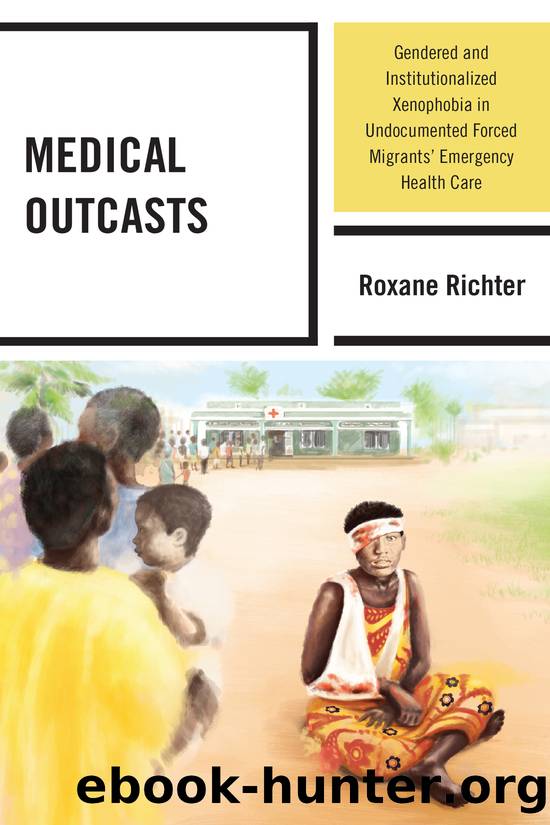Medical Outcasts by Richter Roxane;

Author:Richter, Roxane;
Language: eng
Format: epub
Publisher: Lexington Books
Figure 5.2 Adult HIV/AIDS Infection Rate Comparison in Mexico, South Africa, U.S.A., and Zimbabwe 2008
In the U.S.A. the number of AIDS cases has remained stable since the 1990s, and in 2007 a 69% drop was reported in AIDS-related deaths (since 1994) (UNAIDS/WHO 2008). In the U.S.A., HIV is not even among the top 15 leading causes of death, and mortality rates from AIDS-related causes in 2007 alone dramatically dropped 10% in a single year, yet the costs of antiretroviral (ARV) prescriptions remains at average annual cost of $20,000 (CDC, 2015). But a non-citizenâs access to in-country/host nation ARV treatment can vary greatly, dependent upon a nationâs income level, national and local healthcare laws and access policies, transportation, residential area, logistical and social restrictions, etc. For instance, free antiretroviral treatment (ART) access for non-nationals in South Africa, according Joanna Veareyâs âMigration, Access to ART and Survivalist Livelihood Strategies in Johannesburgâ research, âreflected both the gendered nature of the disease and the gendered patterns of health-seeking behaviorâ in that one-third of the respondents were male and two-thirds were female (2008, 368). She also found that access to ART allowed the migrant women to maintain or regain their survivalist livelihood, depending upon when the treatment was initiated.
So what might be some of the causes behind tuberculosis as the leading cause of death in South Africa in 2010? In truth, the nomenclature âcause of deathâ assigned to some mortality cases can be somewhat misleading and even lead to various misrepresentations. For instance, we know that HIV weakens a personâs immune system, allowing other diseases (like tuberculosis) to affect and eventually kill the patient. But the âcause of deathâ classification attributed and reported to such a case will be TB, not HIV, as the disease which caused the patient to die. But the initial infection of HIV/AIDS should not go unreported, or at least reported as a contributory factorâa comorbid disease (pertaining to a disease or other pathological process that occurs simultaneously with another) in many of these scantily reported global medical mortality and morbidity reports.
Yet another alarming public health risk in South Africa is the current growth of multi-drug resistant tuberculosis (known as MDR-TB) and extensively drug-resistant tuberculosis (known as XDR-TB) in the countryâs provinces. Drug-resistant forms of tuberculosis, both XDR-TB and MDR-TB, are ravaging HIV and other immuno-compromised populations. Since PPD (purified protein derivative) TB testing doesnât seek the Mycobacterium tuberculosis, but rather only tests if the patientâs immune system is combating the bacteriaâmany HIV patients lack sufficient immune activity to either fight the infection or properly respond as âpositiveâ to the PPD test (AIDSMEDS 2012). Therefore, perfunctory TB testing is not as dependable in HIV-positive people with compromised immune systems, so many times a diagnosis of TB will not be made until (further) acute symptoms arise, and/or more sophisticated testing like X-rays, sputum, or blood tests are performed.
In Paul Farmerâs Infections and Inequalities: The Modern Plagues book, he cited five assertions that âhold trueâ for drug-resistant tuberculosis as well as global HIV
Download
This site does not store any files on its server. We only index and link to content provided by other sites. Please contact the content providers to delete copyright contents if any and email us, we'll remove relevant links or contents immediately.
Spell It Out by David Crystal(35811)
Life for Me Ain't Been No Crystal Stair by Susan Sheehan(35504)
Cecilia; Or, Memoirs of an Heiress — Volume 1 by Fanny Burney(32004)
Cecilia; Or, Memoirs of an Heiress — Volume 3 by Fanny Burney(31428)
Cecilia; Or, Memoirs of an Heiress — Volume 2 by Fanny Burney(31371)
The Great Music City by Andrea Baker(30621)
Professional Troublemaker by Luvvie Ajayi Jones(29394)
We're Going to Need More Wine by Gabrielle Union(18586)
Twilight of the Idols With the Antichrist and Ecce Homo by Friedrich Nietzsche(18266)
The Secret History by Donna Tartt(18058)
Cat's cradle by Kurt Vonnegut(14694)
All the Missing Girls by Megan Miranda(14529)
Pimp by Iceberg Slim(13694)
Bombshells: Glamour Girls of a Lifetime by Sullivan Steve(13656)
Fifty Shades Freed by E L James(12874)
Talking to Strangers by Malcolm Gladwell(12797)
Norse Mythology by Gaiman Neil(12751)
The Social Justice Warrior Handbook by Lisa De Pasquale(11930)
Underground: A Human History of the Worlds Beneath Our Feet by Will Hunt(11808)
